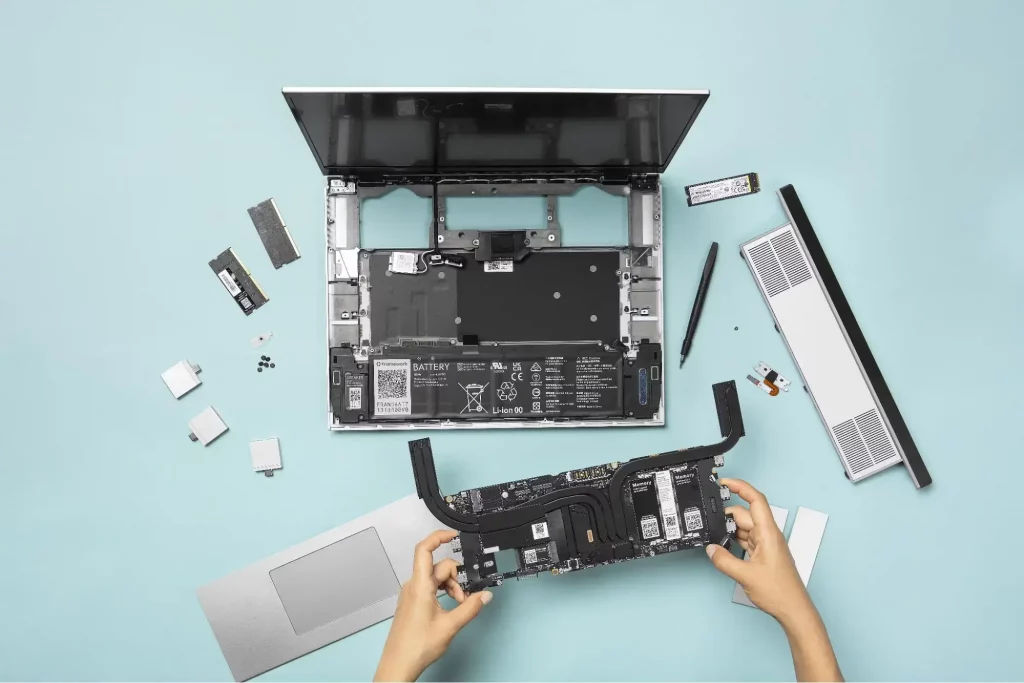As we step into 2025, the technological landscape is rapidly evolving, promising to reshape our daily lives we could only imagine a few years ago. As an entrepreneur and tech enthusiast, I’m particularly excited about the emerging consumer hardware trends. From the immersive experiences of augmented and virtual reality to the convenience of smart homes, the future is brimming with possibilities. In this article, I’ll delve into the key consumer trends that are set to redefine the way we interact with technology.
Mobility and Flying Cars (eVTOLs)
The first trend I want to talk about is mobility. It’s true, the future of urban mobility is taking flight, literally. Electric Vertical Take-Off and Landing vehicles, aka eVTOLs, are poised to revolutionize the way we commute. These flying cars promise to alleviate traffic congestion and reduce travel time, especially in densely populated cities.
Xpeng’s AeroHT
While eVTOLs are still in their early stages of development, companies like Xpeng have already made significant progress. Their AeroHT flying car, capable of both flying and driving, represents a significant step towards personal aerial transportation.
The company plans to start delivering its modular flying car, known as the “Land Aircraft Carrier,” in 2026. The vehicle is priced around $280,000.
The Land Aircraft Carrier features a unique two-module design:
- Ground Module: An all-terrain vehicle equipped with a 6×6 all-wheel drive system that can recharge the air module.
- Air Module: Capable of vertical takeoff and low-altitude flights, designed for both manual and autonomous operation
Before humans graduate to full-fledged flying cars, there are quite a few innovations on the ground that are worth mentioning. Specifically electric bikes and scooters. Both are gaining popularity as sustainable and convenient modes of transportation. We’ve had a number of creators pitch their electric mobility innovations to the world on Prelaunch. With advancements in battery technology and motor design, these vehicles are becoming more powerful, efficient, and user-friendly.
As we move towards a more sustainable future, it’s clear that innovative transportation solutions like eVTOLs and electric bikes will play a crucial role in shaping our cities.
Augmented Reality (AR) Glasses
While we might not see fully realized AR glasses in 2025, the foundation is being laid.
Companies like Meta, with their ambitious Project Orion, are pushing the boundaries of wearable technology. The vision is to create devices that can seamlessly overlay digital information onto our physical world, transforming how we interact with information and each other.
Imagine a world where you can instantly access real-time translations, navigate complex environments with ease, or even play immersive games that blur the lines between the digital and physical realms. AR glasses have the potential to revolutionize industries from healthcare to education, and we’re only beginning to scratch the surface of their possibilities.
Naturally, when you think of cutting-edge tech, you have to think of Apple. The company is undoubtedly continuing to invest heavily in AR as well. So far, there have only been rumors surrounding this development. However, Apple’s track record of innovation and attention to detail suggests that they could potentially surprise us with a groundbreaking AR device. However, it’s more likely that we’ll see continued advancements in their mixed reality headset, the Apple Vision Pro, which could bridge the gap between AR experiences.
As we move closer to 2025, we can expect to see significant advancements in AR technology, leading to more compact, stylish, and powerful devices. While challenges such as battery life and computational power remain, the future of AR is undoubtedly bright.
Flexible and Foldable Display Technologies
The future of displays is flexible, quite literally. We’re witnessing a paradigm shift as manufacturers experiment with screens that can bend, fold, and roll. For those who still remember what it’s like to have a good flip phone, it’s kind of a throwback in a way – but better. This technological leap promises to revolutionize the way we interact with our devices, offering unparalleled versatility and portability.
Samsung as the OLED Frontrunner
Samsung is positioning itself at the forefront of the OLED technology market, emphasizing its commitment to premium, large-screen OLED TVs as a key focus for future consumer trends. This strategic direction was highlighted in their recent earnings statement, which noted that demand for OLED and QLED TVs is expected to grow significantly, driven by consumer interest in high-quality visual experiences and larger displays.
But it’s not just about bigger. The trend I’ve noticed is more about curved and transparent screens. Curved OLED displays offer a more immersive viewing experience, enhancing contrast and reducing reflections. Samsung’s flagship smartphones and TVs often feature these stunning curved screens.

Transparent displays, while still in their early stages, hold immense potential for various applications. For example, I like to imagine a smartphone screen that becomes transparent when not in use, or a smart window that can display information. Samsung has been actively researching and developing transparent OLED technology, bringing us closer to a future where screens blend seamlessly with our surroundings.

Apple: Skin in the OLED Game
Apple, known for its sleek and innovative designs, is also rumored to be exploring foldable iPhone concepts. While the timeline for such a device remains uncertain, I can definitely see this tech giant pushing the boundaries of display technology. So far, what we do know is that Apple plans to switch to OLED displays for all iPhone models sold in 2025 and beyond.
As we move closer to the coming year, we can expect to see more and more devices with flexible and foldable displays. This exciting trend will not only enhance our user experience but also pave the way for entirely new form factors and applications.
Wearable Health Technology
Wearable technology has evolved beyond simple fitness trackers. Today, they’re becoming sophisticated health monitors, capable of providing valuable insights into our physical well-being.
One of the most promising areas of wearable health tech is non-invasive glucose monitoring. Companies are developing devices that can measure blood sugar levels without the need for painful finger pricks. This could be a game-changer for millions of people with diabetes.
Apple is actively developing a non-invasive glucose monitoring device, aiming to integrate this technology into future versions of the Apple Watch. Currently, it is in the “proof-of-concept” stage. The company is developing a new type of chip that can measure blood sugar levels without pricking the skin. This would be a huge improvement for people with diabetes.

And naturally, we can expect to see healthy competition for health devices (pun intended). Several companies are also exploring non-invasive glucose monitoring technologies:
- Know Labs: Developing handheld devices and wristbands that measure blood sugar using radio waves.
- Hagar’s GWave: Utilizing similar technology to measure glucose levels.
- GraphWear: Employing nanotechnology for glucose monitoring solutions.
Another exciting development is the integration of blood pressure monitoring into wearables. Devices like the Withings ScanWatch are already capable of taking accurate ECG and blood oxygen measurements, and we can expect even more advanced health-tracking features in the years to come.

As wearable technology continues to advance, we’re moving closer to a future where we can proactively monitor our health and take steps to prevent potential issues. And hey, if we’re talking really cutting-edge, check out our Prelaunch compilation of innovative health solutions here.
Modular Consumer Electronics
The traditional model of consumer electronics is shifting towards a more sustainable and customizable approach. Modular devices are gaining traction, allowing users to repair, upgrade, and personalize their gadgets. This trend not only empowers consumers but also reduces electronic waste.
Some other benefits I’d mention are:
- Longevity: Modular devices can be repaired and upgraded, extending their lifespan and reducing the need for frequent replacements.
- Customization: Users can tailor their devices to their specific needs, choosing components that best suit their lifestyle and preferences.
- Cost-Effectiveness: By repairing and upgrading components, consumers can save money in the long run.
- Environmental Impact: Modular design reduces electronic waste, contributing to a more sustainable future.
One of the pioneers of modular design is Framework. Their laptops are designed to be easily disassembled and upgraded, making them a great choice for tech-savvy individuals who want to extend the lifespan of their devices.

Fairphone is another company that prioritizes sustainability and modularity. This is one I really love. Their smartphones are built with easily replaceable components, reducing the need for frequent replacements and minimizing electronic waste. (Everyone, who’s ever cracked their screen or wrecked their camera knows just how nice it would be to simply swap out the broken part for a new one.)

As the demand for eco-friendly and customizable devices grows, we can expect to see more and more manufacturers embracing modular design. This shift towards a circular economy is essential for a sustainable future.
Gaming Consoles and Immersive Experiences
The gaming industry is constantly pushing the boundaries of technology, and 2025 promises to be no different. With advancements in display technology and processing power, gamers can expect more immersive and realistic experiences.
4K OLED monitors are set to become the new standard for PC gaming, offering stunning visuals and incredibly fast response times. Companies like Dell and ASUS are already developing high-performance monitors that cater to the needs of serious gamers.
The integration of AR and VR technologies is also transforming the gaming landscape. Immersive experiences that blend the digital and physical worlds are becoming increasingly common. For example, games like Pokémon Go have already shown the potential of AR to bring digital creatures into the real world. As hardware becomes more powerful and affordable, we can expect to see even more innovative AR and VR gaming experiences.
Console gaming will also see significant advancements. Nintendo’s next-generation console is rumored to offer enhanced graphics, innovative gameplay features, and potentially a hybrid design that combines console and handheld gaming. (A far cry from the 1995 Virtual Boy flop.)
For PC gamers, Valve’s Steam Deck 2 is highly anticipated. This portable gaming powerhouse is expected to offer improved performance, longer battery life, and a more refined user experience.
As the gaming industry continues to evolve, we can look forward to a future filled with breathtaking visuals, immersive gameplay, and mind-bending experiences.
Smart Home and AI Integration
The smart home revolution is gaining momentum, with AI-powered devices transforming our living spaces into intelligent environments. As we move closer to 2025, we can expect even more sophisticated and interconnected smart home systems.
Smart home robots like Amazon’s Astro are emerging as versatile companions, capable of performing tasks such as home monitoring, delivering packages, and providing assistance. (Can you imagine not having to get up from the couch when you order food? I know I can.) These robots are powered by advanced AI algorithms that enable them to learn and adapt to our preferences.

Smart kitchen appliances are also becoming increasingly intelligent. Refrigerators equipped with AI can track food inventory, suggest recipes, and even order groceries online. This level of automation can significantly improve our cooking experience and reduce food waste.
One example I love talking about when it comes to this category is Agwa – a home garden solution that uses AI tech and revolutionary automation to grow food without any intervention from you. Incidentally, this is just one of a few projects in which Prelaunch helped validate the concept in the home garden industry.
With Prelaunch, Agwa discovered that:
- They could improve their product by adding an automated system for watering and lighting
- People preferred the larger version that could grow a greater diversity of greens
- Customers value the product most for freshness, flavor, and pod delivery
- A major customer segment loves to fish
As AI continues to advance, we can expect smart homes to become even more personalized and responsive. The future of home automation is bright, with endless possibilities for innovation and convenience.
Conclusion
The advancements expected by 2025 signal a transformative period in consumer hardware. From immersive AR/VR devices and flexible displays to health-monitoring wearables and sustainable modular electronics, these technologies promise to enhance daily life and redefine our interaction with the digital world. The integration of AI in smart homes and the evolution of personal mobility solutions like eVTOLs highlight a future where technology seamlessly integrates into all aspects of living. As we embrace this exciting future, let’s stay curious, open-minded, and ready to adapt to the ever-evolving technological landscape.



